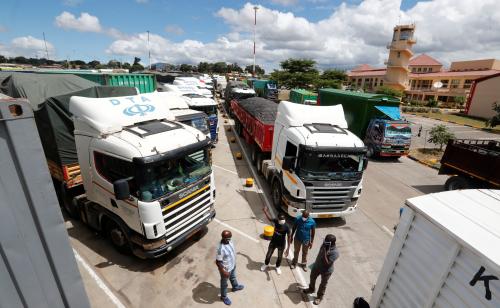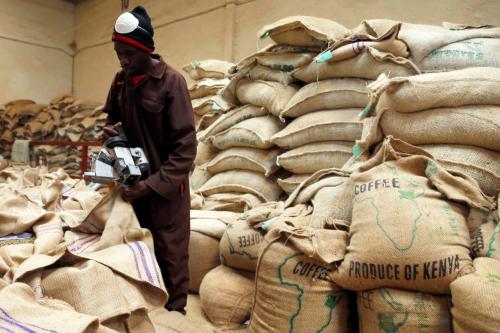Although economic growth in Africa has been on the rise in recent years, it continues to be uneven across the continent’s subregions. According to the African Development Bank’s African Economic Outlook 2020 report, Africa’s economy experienced 3.4 percent growth in 2019, the same rate at which the continent expanded in 2018. However, this growth was largely driven by the expansion of the continent’s “Big 5,” namely, Algeria, Egypt, Morocco, Nigeria, and South Africa. Beyond these five, however, economic growth remained somewhat limited, with some exceptions.
Although contributions to Africa’s growth have been and continue to be uneven across regions, that growth is projected to become more equally distributed in the next couple of years following recent trends (Figure 1). In 2019, North Africa accounted for 44 percent of Africa’s growth, but that share is expected to decline in the next few years. East Africa’s share rose from less than 20 percent of the accounted growth in Africa in 2018 to more than 32 percent in 2019. The biggest jump, however, has been in West Africa, where its share of Africa’s growth has increased over the past few years from 7 percent to 28 percent, which the authors credit in large part to Nigeria’s recent recovery from a recession.
Figure 1. Share of Africa’s GDP growth, by region (percent)
Source: African Economic Outlook 2020 report, African Development Bank.
According to the report, in 2019, East Africa was the continent’s fastest-growing region with 5.0 percent growth; southern Africa was the only region to decline in growth from 2018 to 2019 (1.2 percent vs. 0.7 percent) due to the decline in GDP growth in South Africa. While the report also projects that southern Africa’s growth share will increase in 2021 and 2022, those numbers might change as the report was published in January before the outbreak of COVID-19. Indeed, the continent has already witnessed contractions in the economies of Nigeria and South Africa who have a heavy reliance on the exportation of commodities whose prices have already begun to decline in the face of the pandemic. The authors note that Africa’s growth is largely tied to trade, which has already seen a steep decline from 5.7 percent growth in 2017, to 1.1 percent in 2019 under the pandemic.
As noted above, more than half of Africa’s growth in recent years has been accounted for by the “Big 5” countries of Algeria, Egypt, Morocco, Nigeria, and South Africa (Figure 2), and the authors predict that this trend will continue over the coming years. Egypt alone accounts for one-third of Africa’s GDP growth, which the report attributes to sweeping economic reforms and earlier-than-expected production from its Zohr gas fields.
Figure 2. Contribution to Africa’s GDP growth (percentage points)
Source: African Economic Outlook 2020 report, African Development Bank.
This growth in the continent’s GDP has been strengthened by both investment and net exports since 2014, according to the report. Notably, says the report, it is the first time in a decade that investment expenditure (54 percent) explains more GDP growth than consumption expenditure (31 percent) in Africa. The report also points out rise of net exports in recent years, which led to more aggregate growth than in the past, growing from 1 percent in 2018 to 6 percent in 2019. Beyond exports, the report also attributes recent growth to the production and value-added approach in the services sector, which it says explains more than 50 percent of the growth in the region.
In order to maintain the growth and expansion of African economies, the report recommends deepening structural reforms to diversify Africa’s productive base and revive growth, fostering structural transformation and economic diversification to speed up growth, and improving the efficiency of public investments through capacity building, strengthening expenditure governance frameworks, and proper planning and monitoring of investment projects, among strategies.
Recent AGI policy brief “The impact of the COVID-19 crisis on trade: Recent evidence from East Africa” explores just how the COVID-19 crisis has been and might continue to impact East Africa’s growth. For discussion on how “industries without smokestacks”—services subsectors with characteristics that mimic labor-absorbing industry—can facilitate growth in the region, consult “Industries without smokestacks: Constraints to growth” by John Page.









Commentary
Figures of the week: Regional heterogeneity in Africa’s economic growth predicted to subside
July 30, 2020